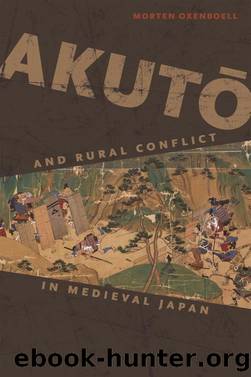AkutÅ and Rural Conflict in Medieval Japan by Oxenboell Morten;

Author:Oxenboell, Morten;
Language: eng
Format: epub
Publisher: University of Hawaii Press
Published: 2018-12-15T00:00:00+00:00
âHe Is Our CrookââThe Estate System and the Protection of Criminals
Proprietary concerns could put a local strongman fellow under increasing pressure, eventually resulting in violent encounters. However, the relationship between known akutÅ and absentee estate proprietors was not always one of antagonism, mutual accusations, and violent attacks, and there are numerous examples of accused akutÅ who operated from within monastic estates and targeted surrounding estates, markets, and other properties. Often these akutÅ received some degree of protection within their estates of residence, and such cases are quite informative of the complex nature of the provincial estates and the power hierarchies within them. Before we return to the conflicts between proprietors and local armed groups, we will look at a few cases in which a proprietor, otherwise extremely vulnerable to attacks from akutÅ or other armed bands, apparently supported or protected such bands against prosecution by shogunate officials.
The early development of the prolonged conflict in Kuroda-no-shÅ illustrates well how accused criminals at times found protection within the borders of an estate where the provincial authorities would have a difficult time apprehending them. From early on, the estate had been involved in conflicts with neighboring estates and provincial authorities, and in the eleventh century TÅdaiji actively encouraged the estate residents to expand the borders of the estate into the adjoining public land (kÅryÅ). Residents in the public land also readily joined this movement, since the estate, and thereby its residents, had been granted dispensations for certain taxes.32
The governor in charge of the public land tried to halt this development, but TÅdaiji does not seem to have budged. When the governor complained about the residentsâ unpaid taxes, the temple seems not to have responded. Subsequently, the governor led military forces into the estate, burnt down sixteen houses, and expropriated more than forty-six chÅ (one chÅ was approximately one hectare) of arable land. In a court decision a couple of years later the border between the estate and the public lands under the governorâs jurisdiction was settled, and at the same time the estate was granted the privilege of noninterference from provincial authorities (fuyufunyÅ«).33
A dispute in 1265 illustrates the often antagonistic relationship between provincial authorities and estate proprietors, which at times even led to the direct or indirect protection of known outlaws and murderers. This case is also a good example of how the concept of noninterference (fuyufunyÅ«) worked in practice when shogunate officials were denied access to apprehend alleged criminals in private, monastic estates. When the shugodai (deputy military governor) in 1265 accused people from the area of committing night raids and robbery, TÅdaiji does not seem to have been very cooperative in apprehending the accused residents. The shugodai, whose name was Masauji, wrote several official letters to the temple administrators and to their local estate managers in which he complained about violent raids committed by a number of people residing on the templeâs property, but neither the temple nor its local representatives took heed of the requests. In fact the shugodai suspected
Download
This site does not store any files on its server. We only index and link to content provided by other sites. Please contact the content providers to delete copyright contents if any and email us, we'll remove relevant links or contents immediately.
| Central Asia | Southeast Asia |
| China | Hong Kong |
| India | Japan |
| Korea | Pakistan |
| Philippines | Russia |
The Sympathizer by Viet Thanh Nguyen(4090)
The Rape of Nanking by Iris Chang(4018)
World without end by Ken Follett(3339)
Ants Among Elephants by Sujatha Gidla(3278)
Blood and Sand by Alex Von Tunzelmann(3055)
Japanese Design by Patricia J. Graham(2996)
City of Djinns: a year in Delhi by William Dalrymple(2430)
Foreign Devils on the Silk Road: The Search for the Lost Treasures of Central Asia by Peter Hopkirk(2385)
Inglorious Empire by Shashi Tharoor(2342)
The Queen of Nothing by Holly Black(2303)
In Order to Live: A North Korean Girl's Journey to Freedom by Yeonmi Park(2301)
India's Ancient Past by R.S. Sharma(2291)
Tokyo by Rob Goss(2286)
India's biggest cover-up by Dhar Anuj(2240)
Tokyo Geek's Guide: Manga, Anime, Gaming, Cosplay, Toys, Idols & More - The Ultimate Guide to Japan's Otaku Culture by Simone Gianni(2234)
The Great Game: On Secret Service in High Asia by Peter Hopkirk(2227)
Goodbye Madame Butterfly(2161)
Batik by Rudolf Smend(2005)
Living Silence in Burma by Christina Fink(1975)
